In today’s rapid digital pace, every restaurant needs some newfound ideas to allure new and repeat customers.
Among the most effective tools at their command is Google Ads.
Millions of people search for dining every day; leveraging this platform will considerably raise the visibility and foot traffic of any restaurant.
But how does it work for restaurants to maximize this omnipotentHaving unlimited or very great power. marketing tool?
This guide will take you through the essential steps to create and optimize Google Ads campaigns tailored specifically for restaurants.
- Introduction to Google Ads for Restaurants
- Setting Up a Google Ads Campaign for Your Restaurant
- Optimizing Your Google Ads Campaign for Maximum Impact
- Measuring Success: Key Metrics for Restaurant Google Ads
- Common Mistakes to Avoid in Restaurant Google Ads Campaigns
- Mastering Google Ads for Restaurants: A Roadmap to Success
- Google Ads for Restaurants: Frequently Asked Questions
Introduction to Google Ads for Restaurants
Google Ads is not just a means for online advertising; it is a gateway to connecting your restaurant with potential diners who are looking for places to eat.
Be it a small café, a fine-dining establishment, or even a fast-food joint, Google Ads literally put your business on the map.
But why is this so effective for restaurants?
First and foremost, Google Ads allows restaurants to target audiences with precision.
By utilizing features like local targeting and keyword optimization, you can ensure your ads reach people in your area who are ready to dine out.
Additionally, it offers a range of ad formats, including search ads, display ads, and even video ads, to showcase your restaurant’s unique offerings.
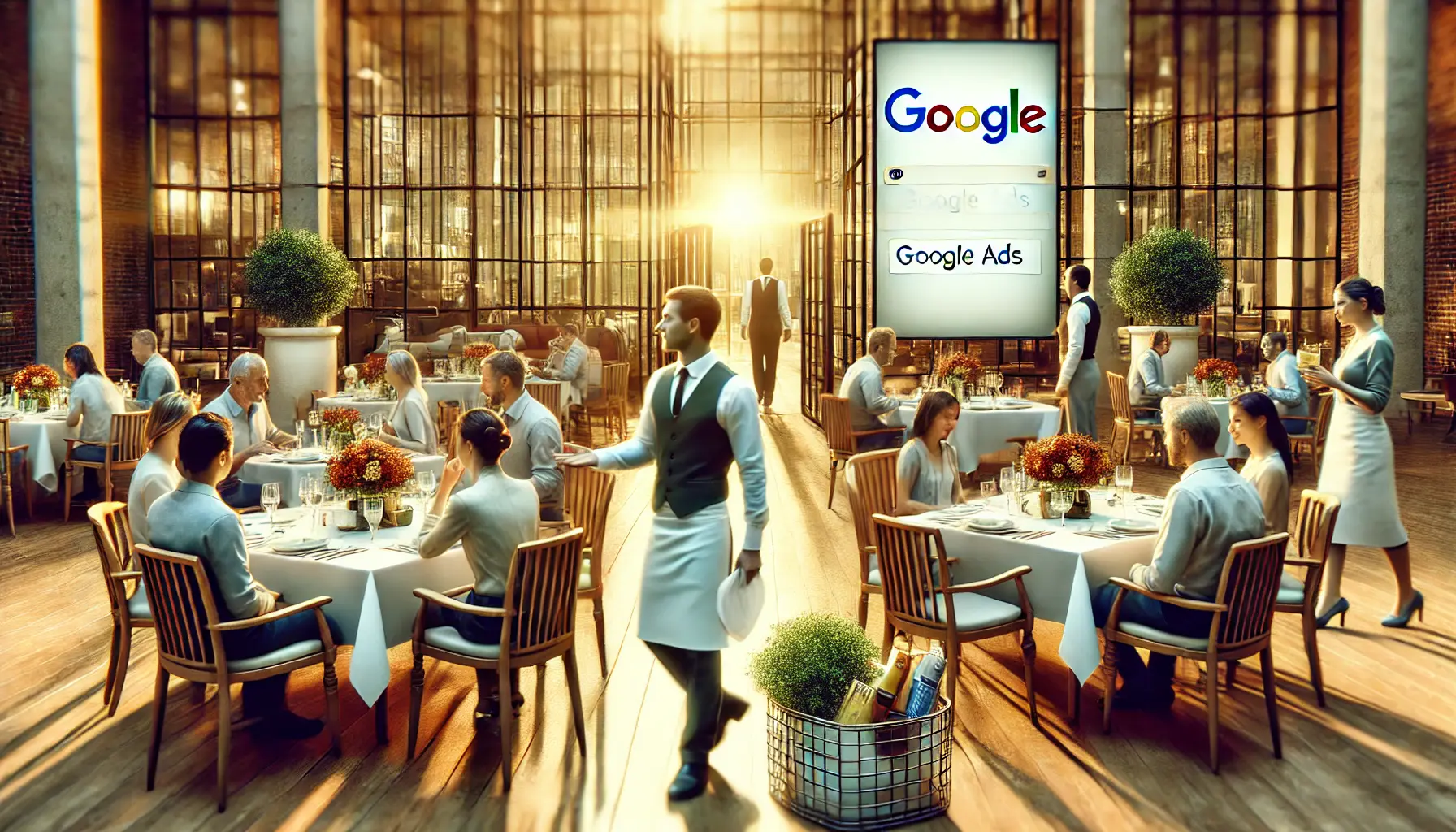
Dynamic restaurant setting showcasing the role of marketing and customer engagement.
What Makes Google Ads Essential for Restaurants?
Google Ads has become a must-have solution for restaurant marketing since the platform provides the ability to deliver completely measurable results.
Here’s why it stands apart:
- Local Targeting: Restaurants can target customers who are nearby, which guarantees that they reach the most likely visitors.
- Cost-Effective: With PPC advertising, you only pay when someone clicks on your ad, making it considerably more budget-friendly.
- Customizability: Google Ads offers flexible options to fit every restaurant’s needs, from showcasing menus to promoting seasonal offers.
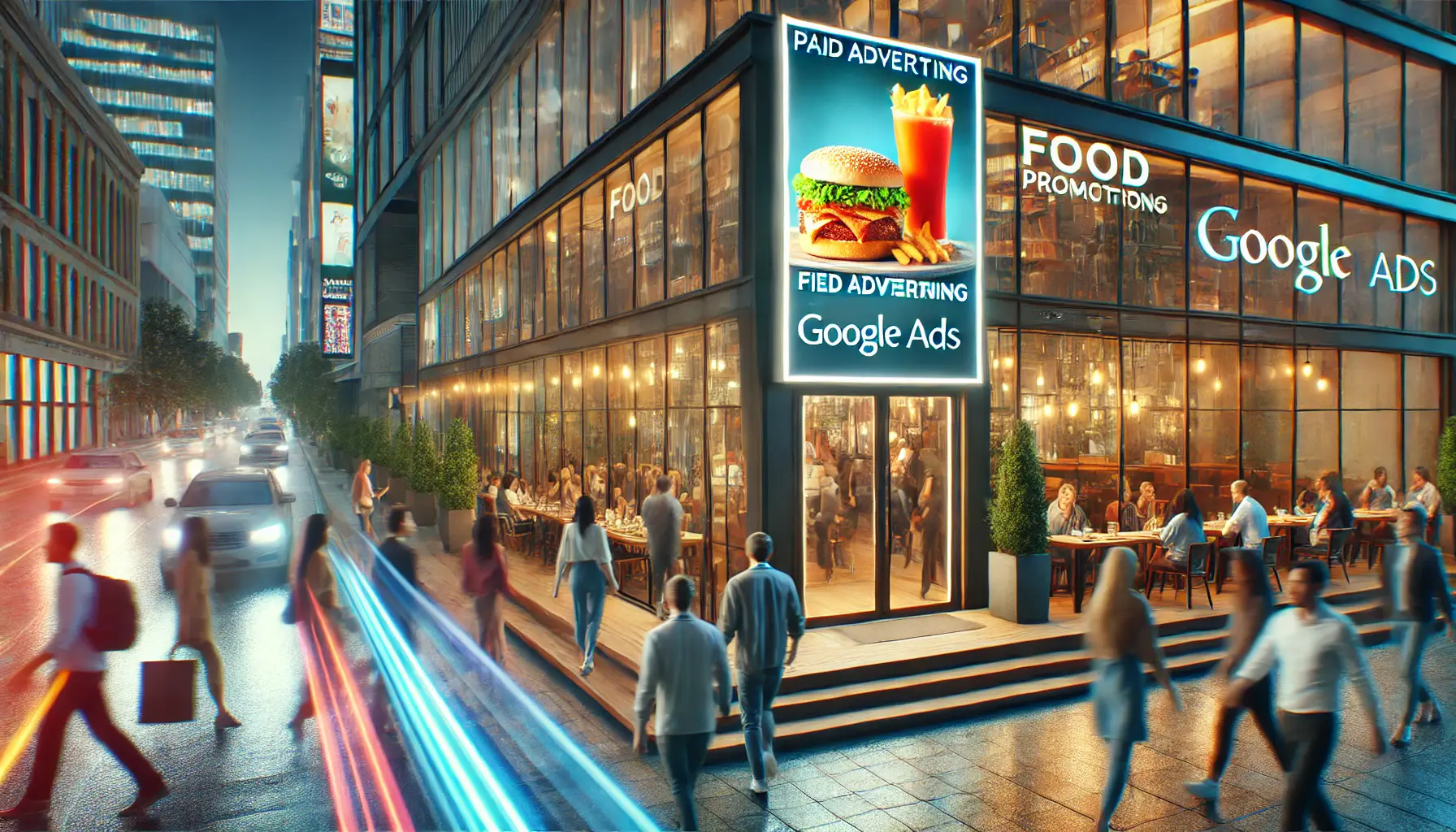
undefined
How Restaurants Can Benefit from Paid Advertising
Using Google Ads can transform how your restaurant connects with potential customers.
Some key benefits include:
- Increased Visibility: Appearing at the top of search results ensures your restaurant is seen first by hungry diners.
- Improved Brand Awareness: Even if users don’t click, seeing your ad repeatedly reinforces your restaurant’s presence.
- Enhanced Engagement: With interactive ad formats, you can captivate audiences and encourage them to visit your restaurant.
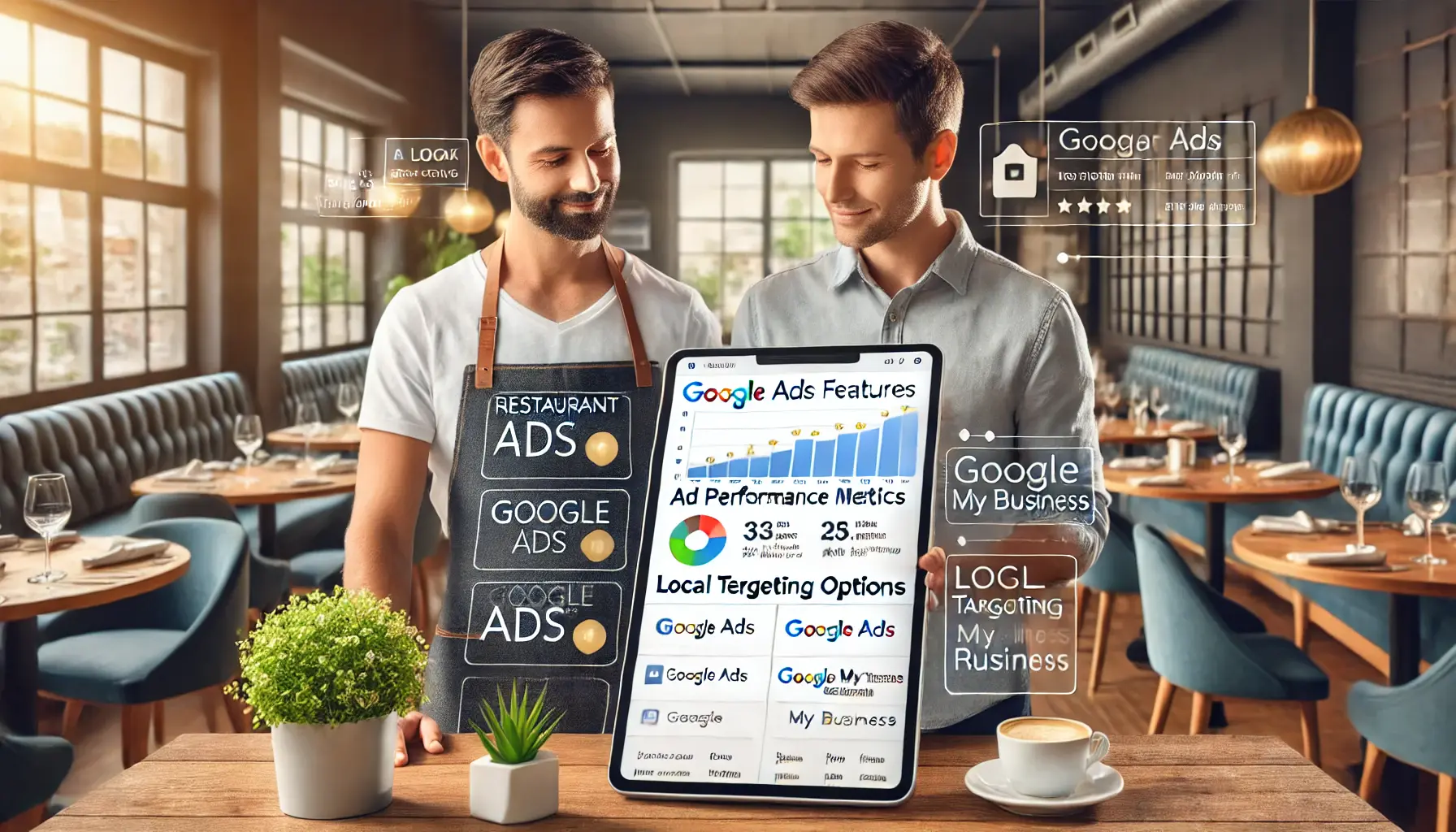
Using Google Ads features to optimize restaurant marketing.
Overview of Google Ads Features Tailored for Restaurants
Google Ads offers specific features designed to help restaurants stand out:
- Google My Business Integration: Sync your ads with your business profile to provide location, hours, and contact details directly in the ad.
- Ad Extensions: Add call-to-action buttons, links to your menu, or promotional offers to make your ads more effective.
- Performance Tracking: Use analytics to measure clicks, conversions, and ROI, helping you refine your strategy.
By understanding and making use of these features, your restaurant can make the most out of Google Ads and keep an edge in the competitive dining industry.
Google Ads is a powerful platform to connect your restaurant with potential diners. It offers local targeting and various ad formats, making it essential for restaurant marketing.
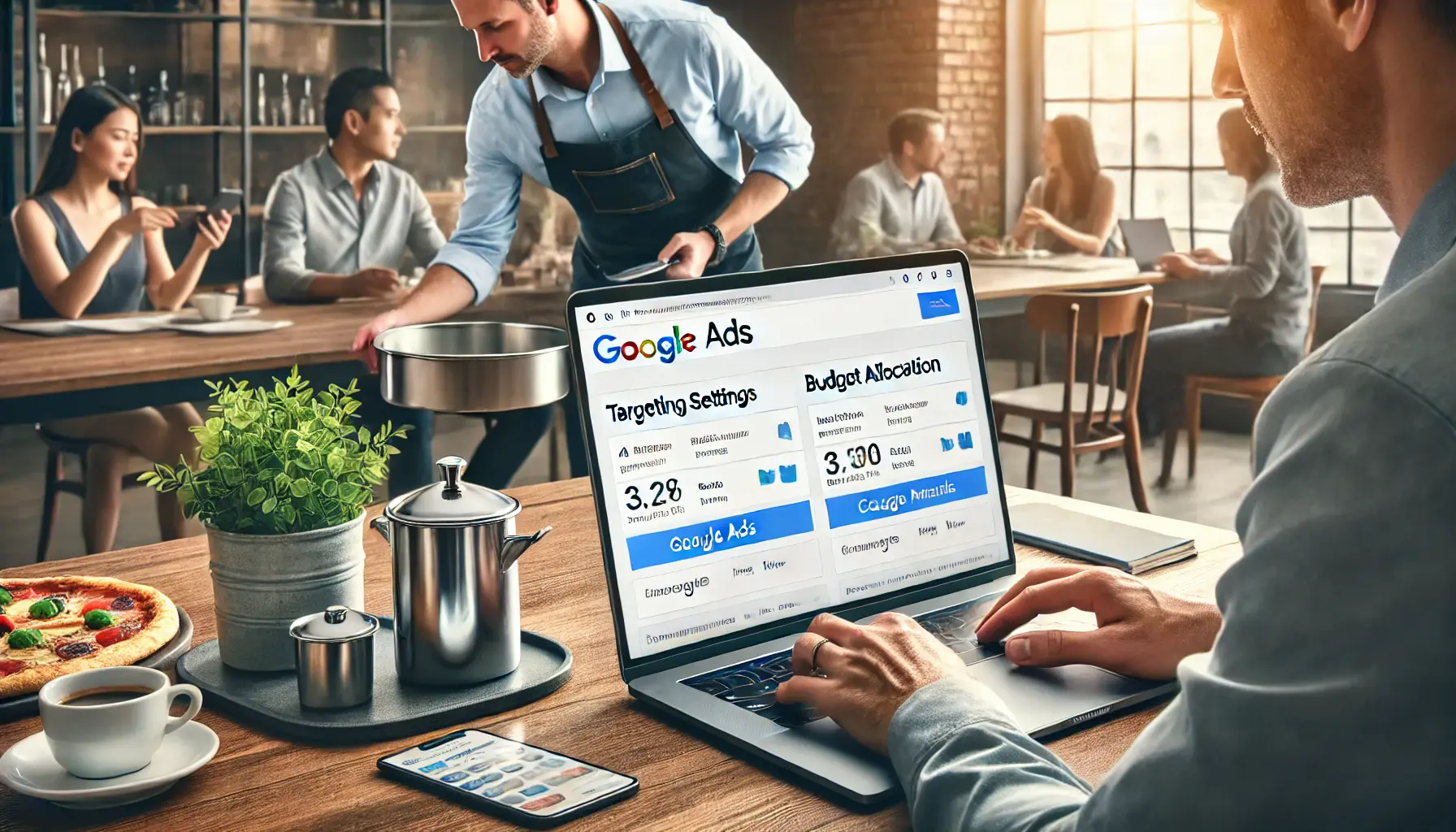
Collaborating on a Google Ads campaign setup for a restaurant.
Setting Up a Google Ads Campaign for Your Restaurant
Embarking on a Google Ads campaign can significantly enhance your restaurant’s visibility and attract more patrons.
However, to maximize its effectiveness, it’s crucial to set up your campaign thoughtfully.
Let’s delve into the key steps to ensure your restaurant’s advertising efforts are both efficient and impactful.
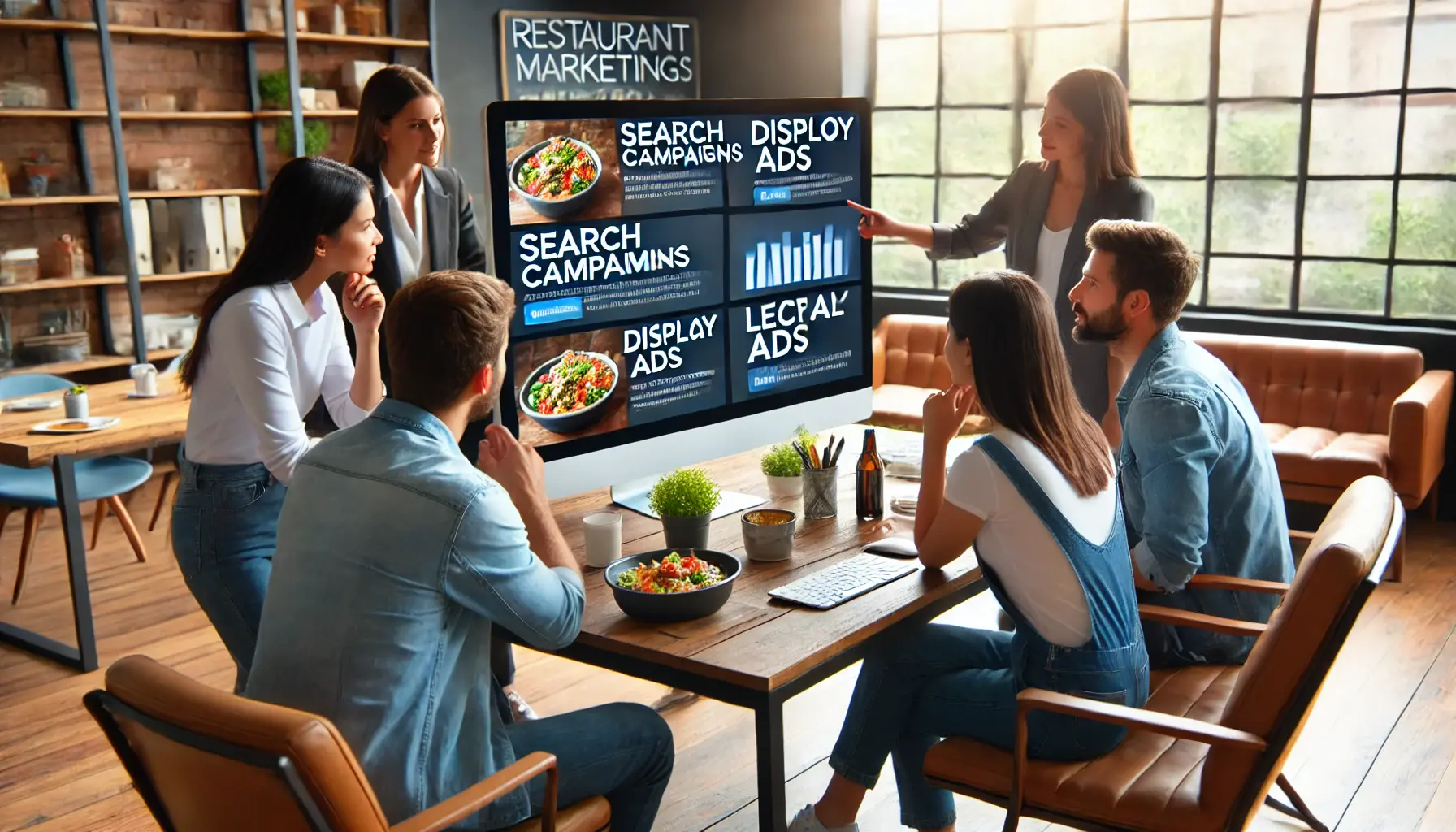
Deciding on the right campaign strategy for a restaurant’s digital marketing.
Choosing the Right Campaign Type for Restaurants
Google Ads provides different campaign types, each targeted at specific marketing objectives.
Restaurants focused on catching local diners will benefit most from the following campaign types:
- Search Campaigns: These ads appear in Google search results when people search using terms related to your restaurant, such as “best Italian restaurant near me.” This captures potential customers actively looking for places to dine.
- Display Campaigns: Visually appealing banners published on Google’s network of partner websites. This ad format creates brand awareness and reaches a wider audience.
- Local Campaigns: Designed for businesses with physical locations, these campaigns help advertise your restaurant to drive foot traffic across various Google platforms like Maps and YouTube.
Selecting the appropriate campaign type aligns your advertising strategy with your restaurant’s goals, whether it’s increasing reservations, promoting a new menu, or enhancing brand recognition.

Optimizing geo-targeting settings to reach local customers.
Targeting Local Customers with Geo-Targeting
For restaurants, attracting local patrons is paramount.
Geo-targeting allows you to focus your ads on users within a specific geographic area, ensuring your promotions reach those most likely to visit.
To implement effective geo-targetingA method of delivering content or ads to users based on their geographic location.:
- Define Your Service Area: Determine the radius around your restaurant where most of your customers reside or work.
- Set Location Targets: In your Google Ads settings, specify the cities, zip codes, or radius to target. This ensures your ads are shown to users within these areas.
- Exclude Irrelevant Areas: To optimize your budget, exclude regions where your restaurant doesn’t serve or where customers are unlikely to travel from.
By honing in on your local audience, you increase the likelihood of attracting diners who are in proximity and ready to enjoy your offerings.

Collaborating on creating effective ad copy for restaurant promotions.
Crafting Effective Ad Copy for Restaurant Promotions
Your ad copy serves as the first impression potential customers have of your restaurant.
Crafting compelling and relevant messages is essential to entice clicks and visits.
Consider the following tips:
- Highlight Unique Selling Points: Emphasize what sets your restaurant apart, such as signature dishes, ambiance, or special dietary options.
- Include a Clear Call-to-Action (CTA): Add phrases like “Reserve a Table Now,” “Order Online Today,” or “View Our Menu” to guide users on the next steps.
- Use Keywords: Include relevant keywords that potential diners may use when searching for dining spots, helping improve ad relevance and visibility.
- Keep It Concise: Ensure your message is clear and concise, as people often view ads on small screens.
Engaging ad copy not only attracts attention but also encourages potential diners to take action, whether it’s making a reservation or exploring your menu.
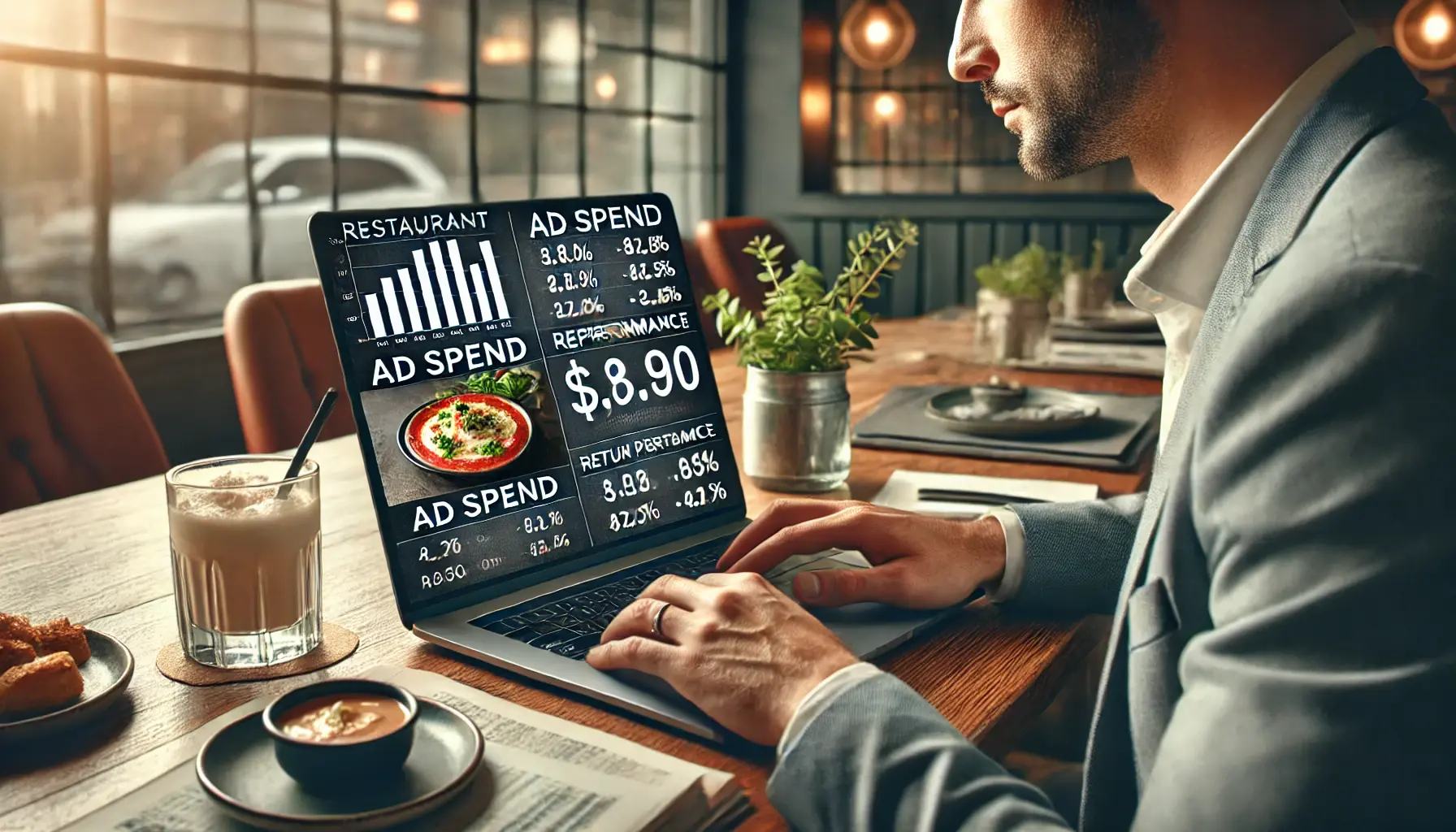
Analyzing ad performance and budgeting strategies for restaurant promotions.
Budgeting Strategies for Restaurant Ads
Effective budgeting ensures you get the most out of your advertising spend without overshooting your marketing budget.
To allocate your budget wisely:
- Set a Daily Budget: Decide how much you are willing to spend daily. This keeps your costs in check and ensures your ad is shown consistently every day.
- Choose Your Bidding Strategy: Google Ads offers options like cost-per-click (CPC) and cost-per-thousand-impressions (CPM). Restaurants often benefit more from CPC since you pay only when someone clicks on your ad.
- Monitor and Adjust: Regularly evaluate your campaign’s performance. If certain ads or keywords perform well, allocate more budget to them, and reduce spending on underperforming areas.
- Use Ad Scheduling: Display your ad during peak hours when searches for dining options are most likely, such as lunch and dinner times.
By budgeting strategically, you will maximize your return on investment from Google Ads campaigns, ensuring your restaurant attracts more patrons without unnecessary expenditure.
Setting up a Google Ads campaign involves thoughtful preparation, from choosing the right campaign type to targeting the ideal audience with precision.
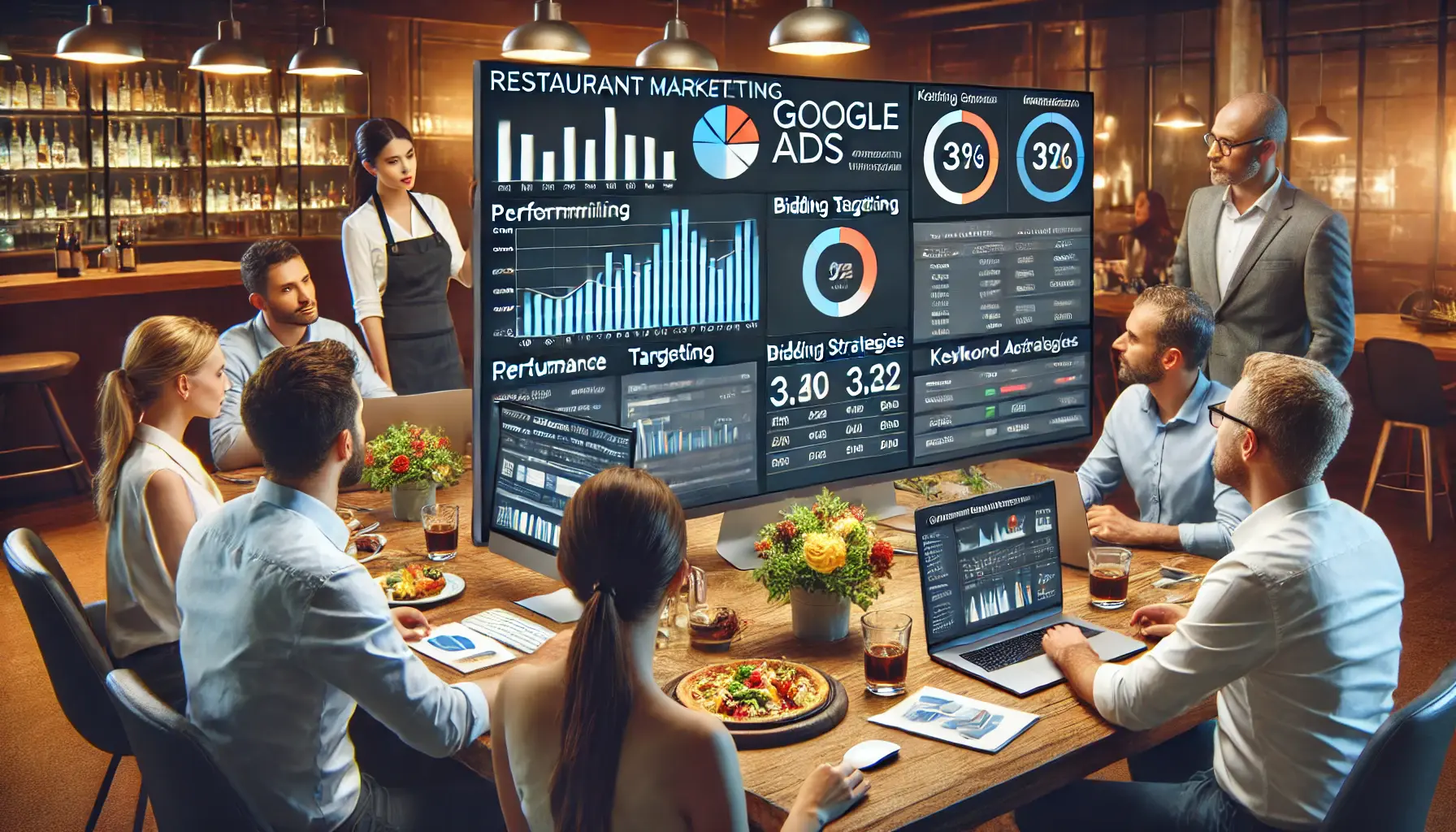
Optimizing a Google Ads campaign for better restaurant marketing results.
Optimizing Your Google Ads Campaign for Maximum Impact
Once your Google Ads campaign is up and running, the next crucial step is optimization.
Fine-tuning your campaign ensures that your restaurant’s ads reach the right audience, at the right time, with the right message.
Let’s explore strategies to enhance your campaign’s performance and drive more customers to your establishment.
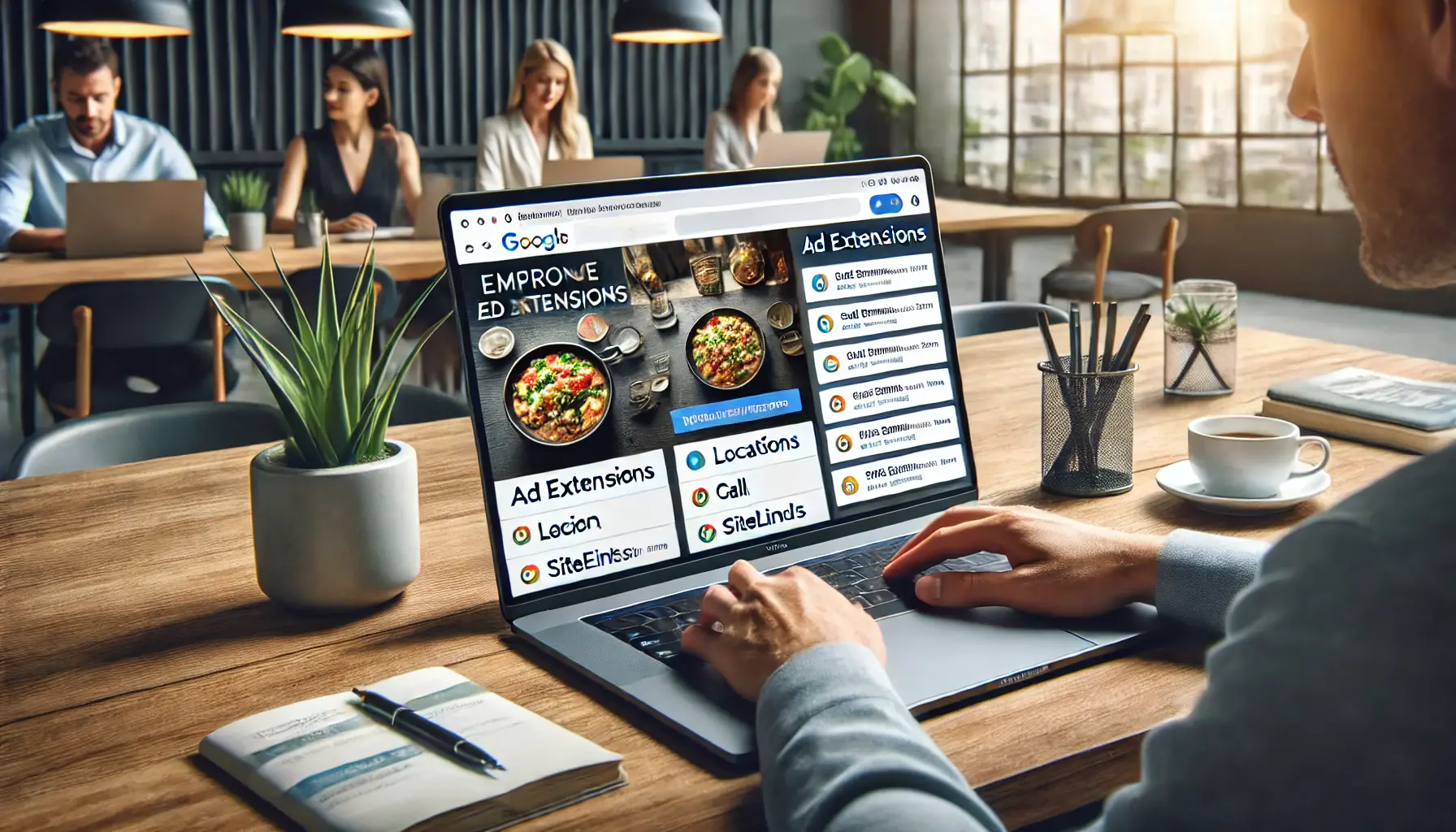
undefined
Utilizing Ad Extensions to Enhance Visibility
Ad extensions are extra information added to your ad, which makes it more informative and engaging.
Restaurants benefit greatly from leveraging ad extensions, enhancing their click-through rates and providing important details to potential customers.
Consider the following extensions:
- Location Extensions: Allow users to see your restaurant address, a map to your location, or the distance to your establishment. This makes it easier for them to locate you and is highly efficient for mobile users seeking nearby dining options.
- Call Extensions: Add a phone number to your ad, allowing users to call your restaurant with just one tap. It is great for reservations and inquiries.
- Sitelink Extensions: Add additional links to specific pages on your website, such as the menu, reservations, or special offers. This directs users to the most relevant information on your site.
- Promotion Extensions: Highlight special deals or promotions, such as “20% off dinner entrees this weekend.” This can encourage users to choose your restaurant over competitors.
By incorporating these ad extensions, your ads become more comprehensive and appealing, increasing the likelihood of attracting potential diners.
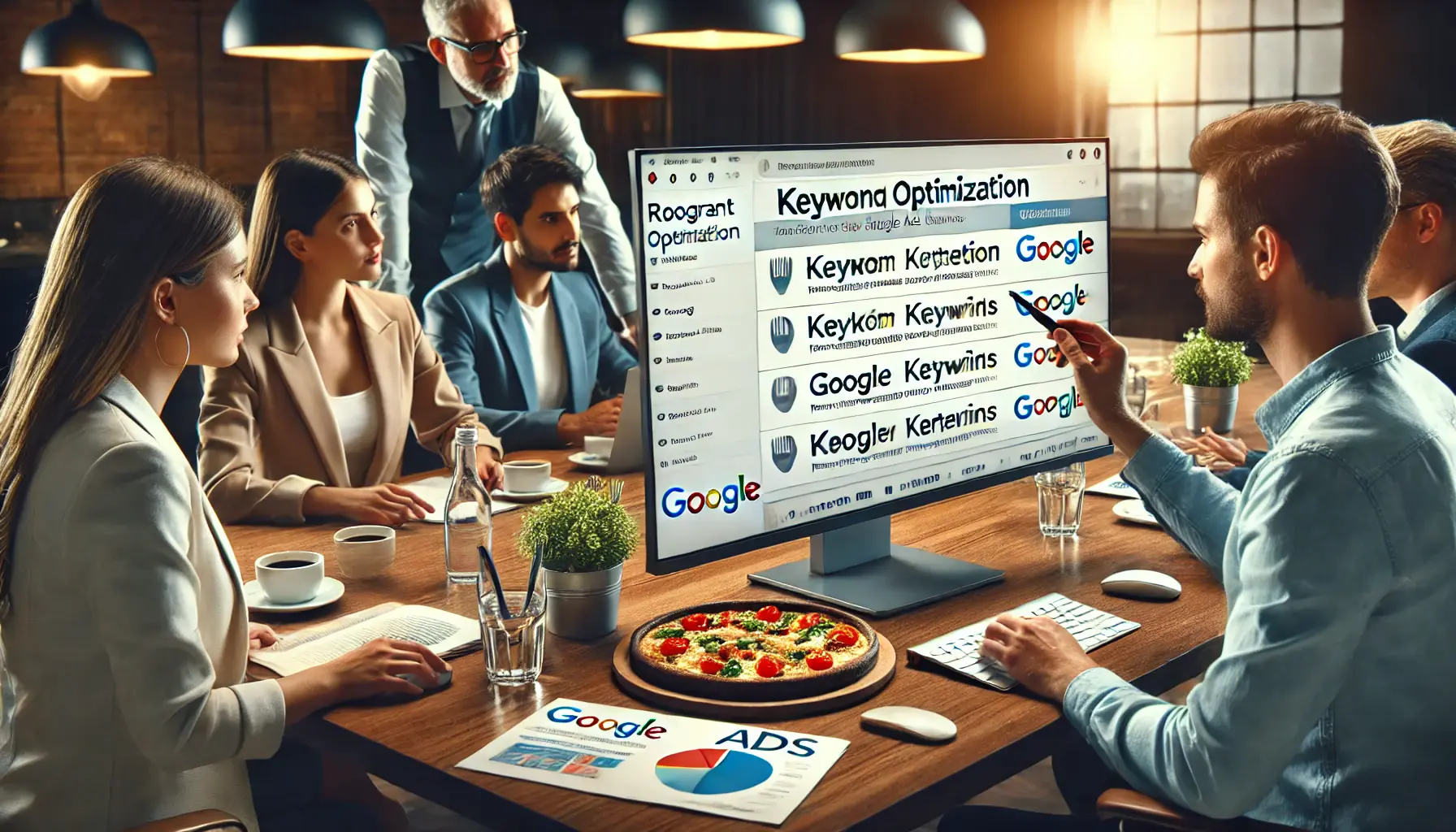
Strategizing keyword optimization for improved ad targeting in a restaurant’s digital campaign.
Implementing Keyword Optimization for Better Targeting
Keywords are the foundation of your Google Ads campaign.
Selecting and optimizing the right keywords ensures your ads appear when potential customers search for relevant terms.
Follow these steps for effective keyword optimization:
- Conduct Thorough Keyword Research: Use tools such as Google’s Keyword Planner to identify popular search terms related to your cuisine, location, and the services your restaurant provides.
- Use Long-Tail Keywords: Focus on specific phrases like “vegan brunch in [City]” rather than generic terms like “restaurant.” Long-tail keywords often have less competition and drive more targeted traffic.
- Include Negative Keywords: Add words that don’t relate to your restaurant to keep your ad out of irrelevant searches, preserving budget and maintaining relevance.
- Monitor and Adjust: Regularly review keyword performance. Pause or remove poorly performing keywords and reallocate budget to high-performing ones.
Effective keyword optimization ensures your ads reach the audience most likely to be interested in your restaurant, enhancing the efficiency of your advertising spend.

Reviewing and adjusting campaign performance for improved restaurant marketing results.
Analyzing and Adjusting Campaign Performance
Continuous monitoring and analysis are vital to the success of your Google Ads campaign.
By understanding what’s working and what isn’t, you can make informed adjustments to improve performance.
Consider the following practices:
- Set Up Conversion Tracking: Measure how many reservations, online orders, calls, or other specific actions come from your ads. This data helps calculate the return on investment (ROI) of your campaign.
- Review Key Metrics: Monitor metrics such as click-through rate (CTR), cost-per-click (CPC), and conversion rate to evaluate ad performance.
- Run A/B Testing: Test various ad copies, headlines, and images to identify the best-performing variations and use the learnings to optimize your ads.
- Update Bids and Budgets: Reallocate budget to top-performing ads and keywords based on performance data. Consider increasing bids on successful keywords to improve ad positioning.
By regularly analyzing and adjusting your campaign, you ensure that your advertising efforts remain effective and aligned with your restaurant’s marketing goals.
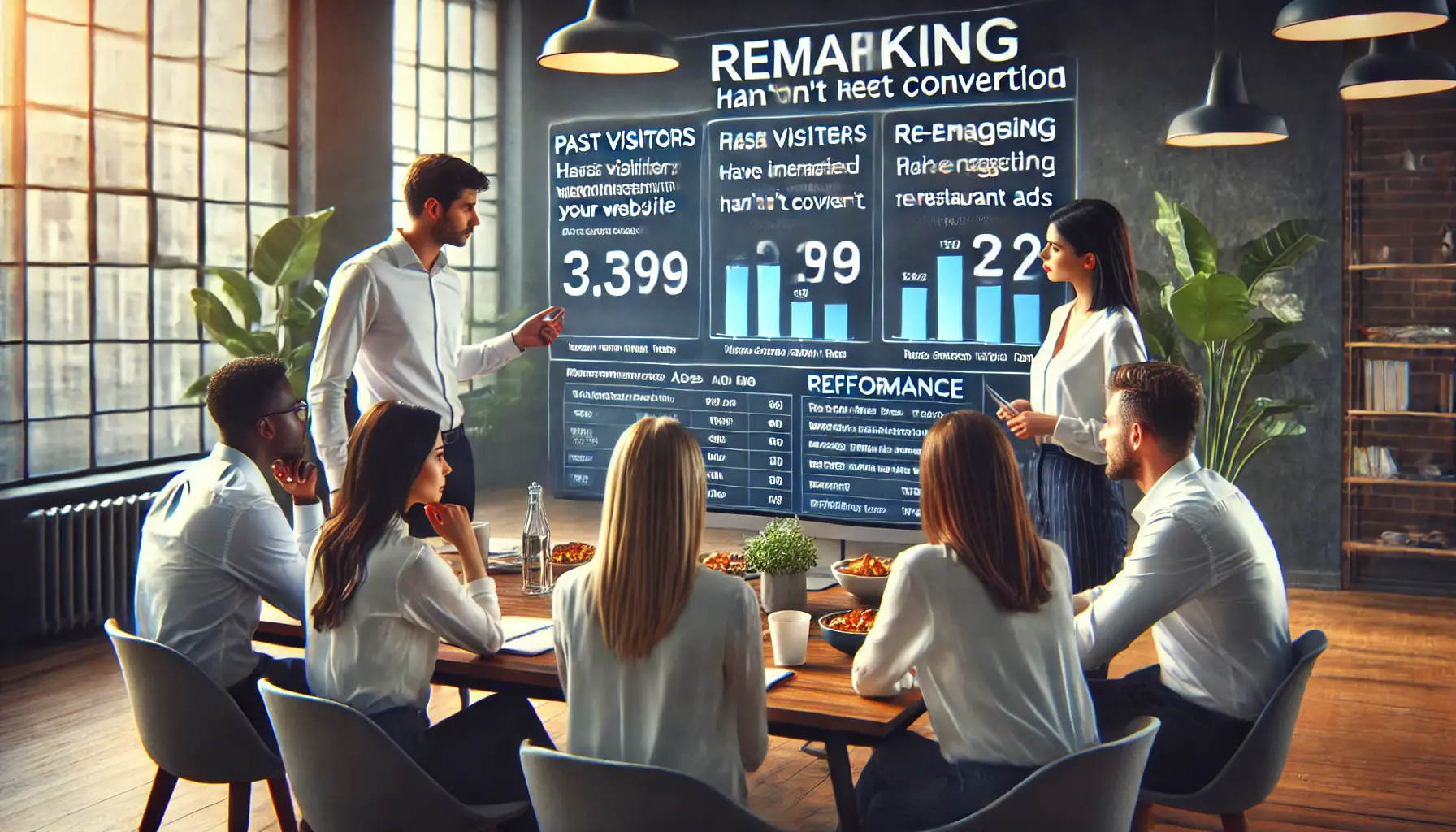
Strategizing remarketing campaigns to re-engage potential customers for a restaurant.
Leveraging Remarketing to Re-engage Potential Customers
Remarketing allows you to target users who have previously interacted with your website or ads but haven’t converted into customers.
This strategy keeps your restaurant top-of-mind and encourages potential diners to return.
To implement remarketingA digital marketing strategy to re-engage users who previously interacted with a website or ad.:
- Create Remarketing Lists: Segment users based on their behavior, such as those who viewed the menu page but didn’t complete a reservation.
- Design Tailored Ads: Create ads that address specific interests or actions of each segment, such as offering users who abandoned the reservation process a special discount.
- Set Frequency Caps: Limit the number of times your remarketing ads are shown to avoid overwhelming potential customers.
- Monitor Performance: Track the performance of your remarketing campaigns and adjust strategies as needed to optimize results.
Remarketing is an effective way to re-engage interested users and convert them into loyal customers, enhancing the overall success of your Google Ads campaign.
- Utilize ad extensions to enhance visibility.
- Focus on keyword optimization for better targeting.
- Analyze performance metrics to refine your campaign.
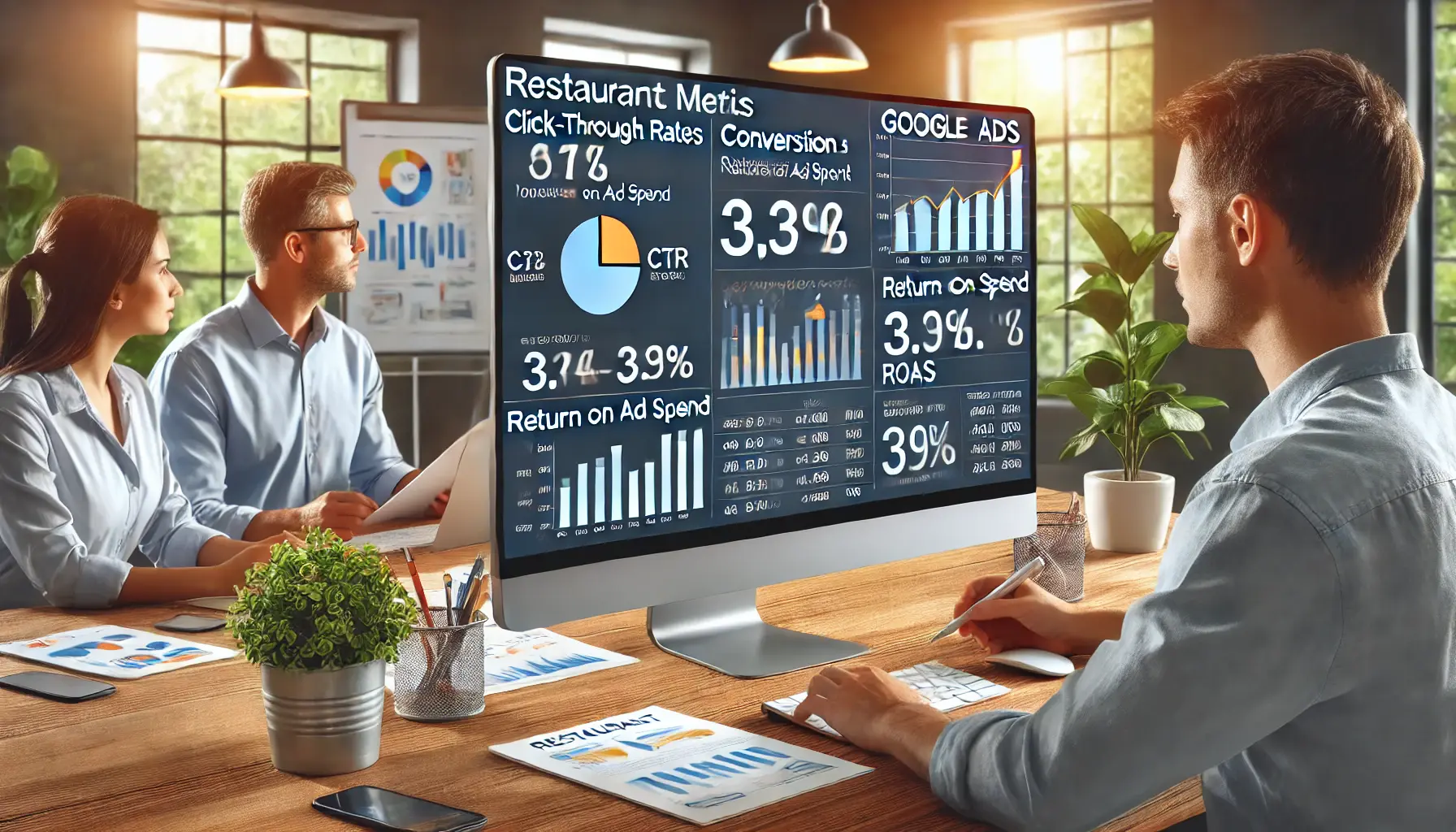
Analyzing key metrics to measure the success of a restaurant’s Google Ads campaign.
Measuring Success: Key Metrics for Restaurant Google Ads
To ensure your restaurant’s Google Ads campaigns are effective, it’s essential to monitor and analyze key performance metrics.
By understanding these indicators, you can make informed decisions to optimize your advertising efforts and maximize return on investment (ROI).
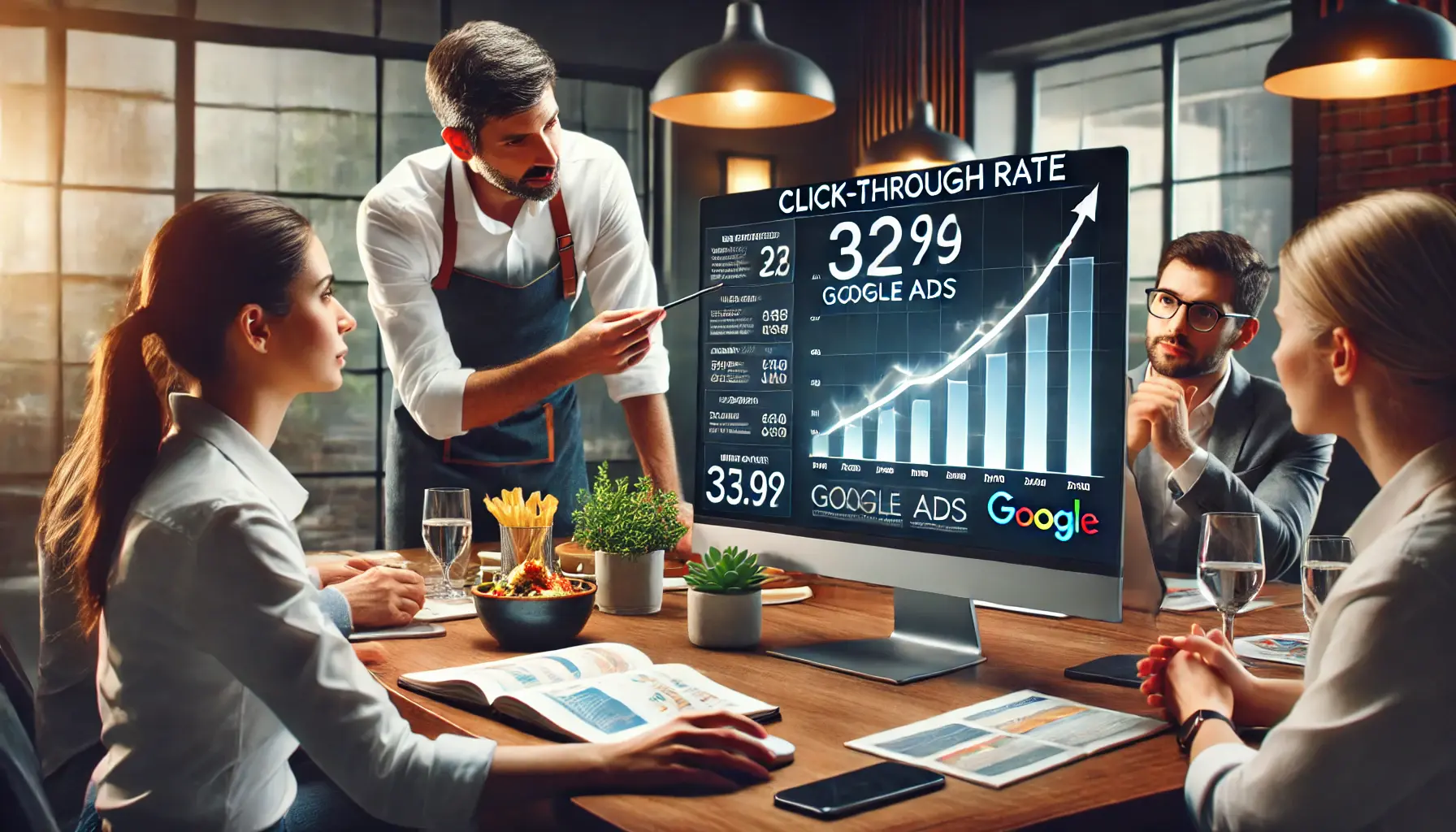
Reviewing and optimizing the click-through rate (CTR) to improve ad engagement.
Click-Through Rate (CTR)
CTR refers to the proportion of users who click on your ad after seeing it.
A higher CTR indicates that your ad is relevant and engaging to your target audience.
For better CTR:
- Create Catchy Ad Copy: Highlight unique selling propositions and include urgency-based calls-to-action.
- Use Ad Extensions: Display additional information like location, phone number, or deep links to other pages.
- Target Relevant Keywords: Ensure your ads appear for search terms relevant to your restaurant’s offerings.
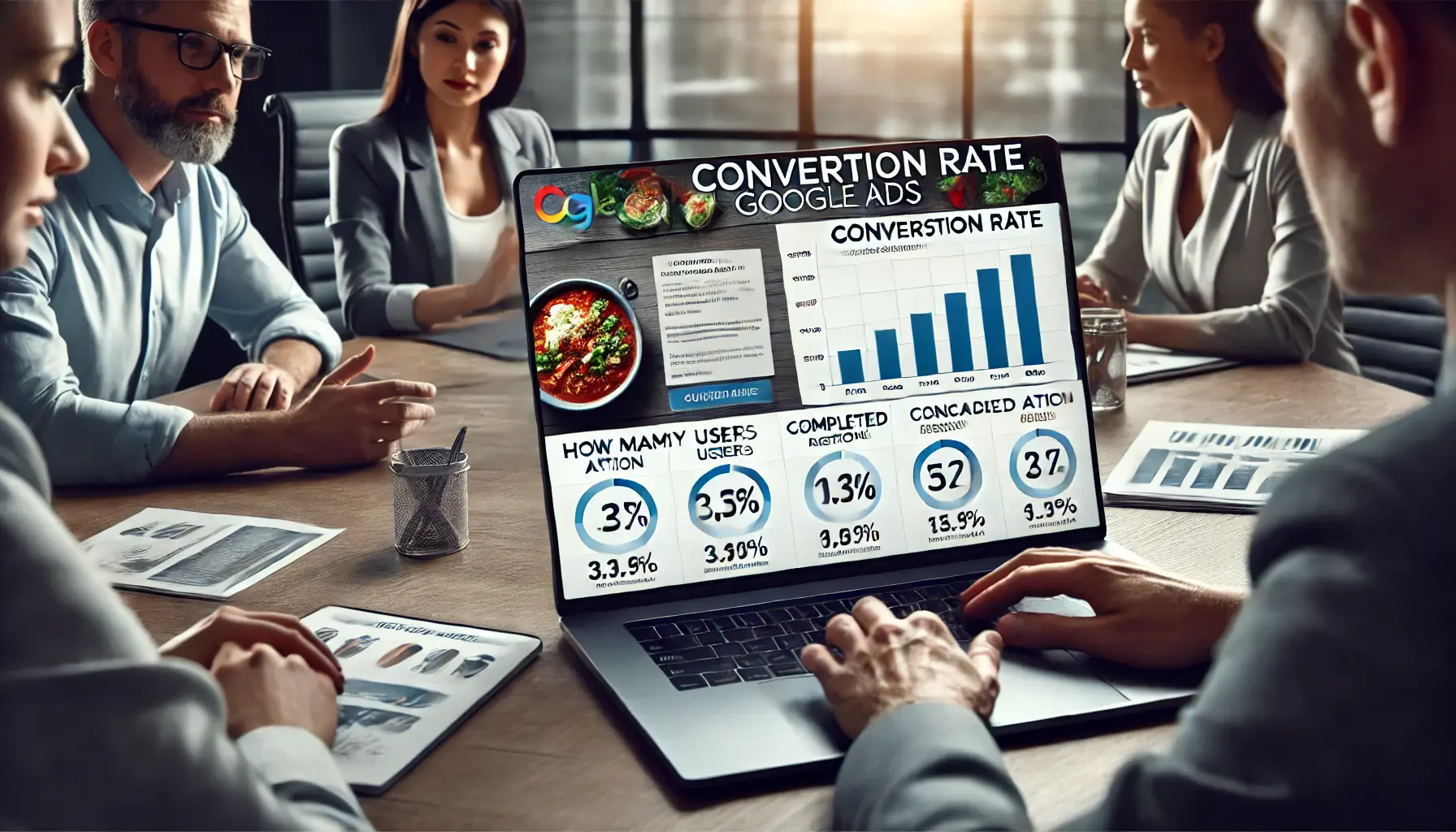
Analyzing and improving conversion rate to measure campaign success.
Conversion Rate
Conversion rate refers to the percentage of users who, after clicking on your ad, complete a meaningful transaction, such as reservations or online orders.
To improve conversion rates:
- Landing Page Optimization: Ensure pages are user-friendly, load quickly, and provide clear information.
- Simplify the Conversion Process: Reduce the number of steps required to complete actions such as making reservations or placing orders.
- Incentives: Special offers and discounts encourage users to take action.

Analyzing cost per click (CPC) to optimize ad spending for a restaurant’s campaign.
Cost Per Click (CPC)
CPC is the cost of a single click on your ad.
Keeping CPC in check is crucial to maintaining a profitable campaign.
To control CPC:
- Focus on High-Performing Keywords: Allocate budget to keywords that drive quality traffic.
- Use Negative Keywords: Exclude irrelevant terms to avoid unnecessary clicks.
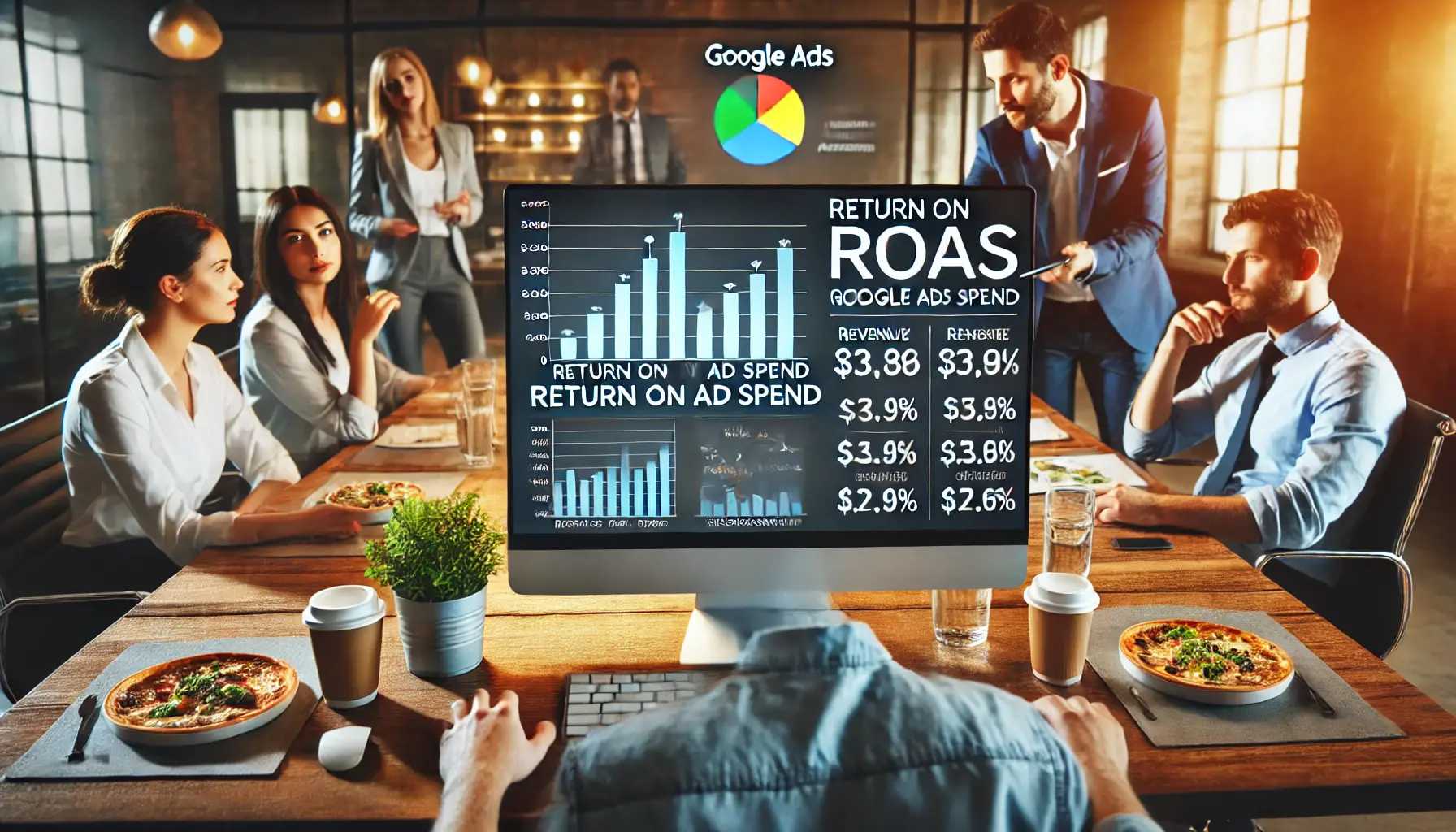
Analyzing return on ad spend (ROAS) to optimize restaurant ad campaigns for better profitability.
Return on Ad Spend (ROAS)
ROAS measures the revenue generated for every dollar spent on advertising.
A higher ROAS indicates a more profitable campaign.
To improve ROAS:
- Track Conversions Accurately: Use tools like Google Analytics to monitor sales and reservations generated by ads.
- Optimize Ad Targeting: Focus on audiences more likely to convert, such as local diners.
- Refine Ad Creative: Continuously test and optimize ad visuals and copy to boost engagement.

undefined
Impression Share
Impression share measures the percentage of times your ad is shown compared to the total available impressions.
A higher impression share reflects greater visibility.
To increase impression share:
- Increase Budget: Allocate more funds to campaigns to compete for impressions.
- Improve Ad Quality: Enhance relevance and quality scores through better targeting to win auctions at lower costs.
- Expand Keyword List: Add more relevant keywords to capture higher search volumes.
By regularly reviewing these key metrics, you can evaluate the performance of your Google Ads campaigns and make data-driven decisions to attract more customers to your restaurant.
- CTR indicates ad relevance and engagement.
- Conversion rate measures the effectiveness of driving actions like reservations.
- ROAS evaluates the profitability of your campaign.
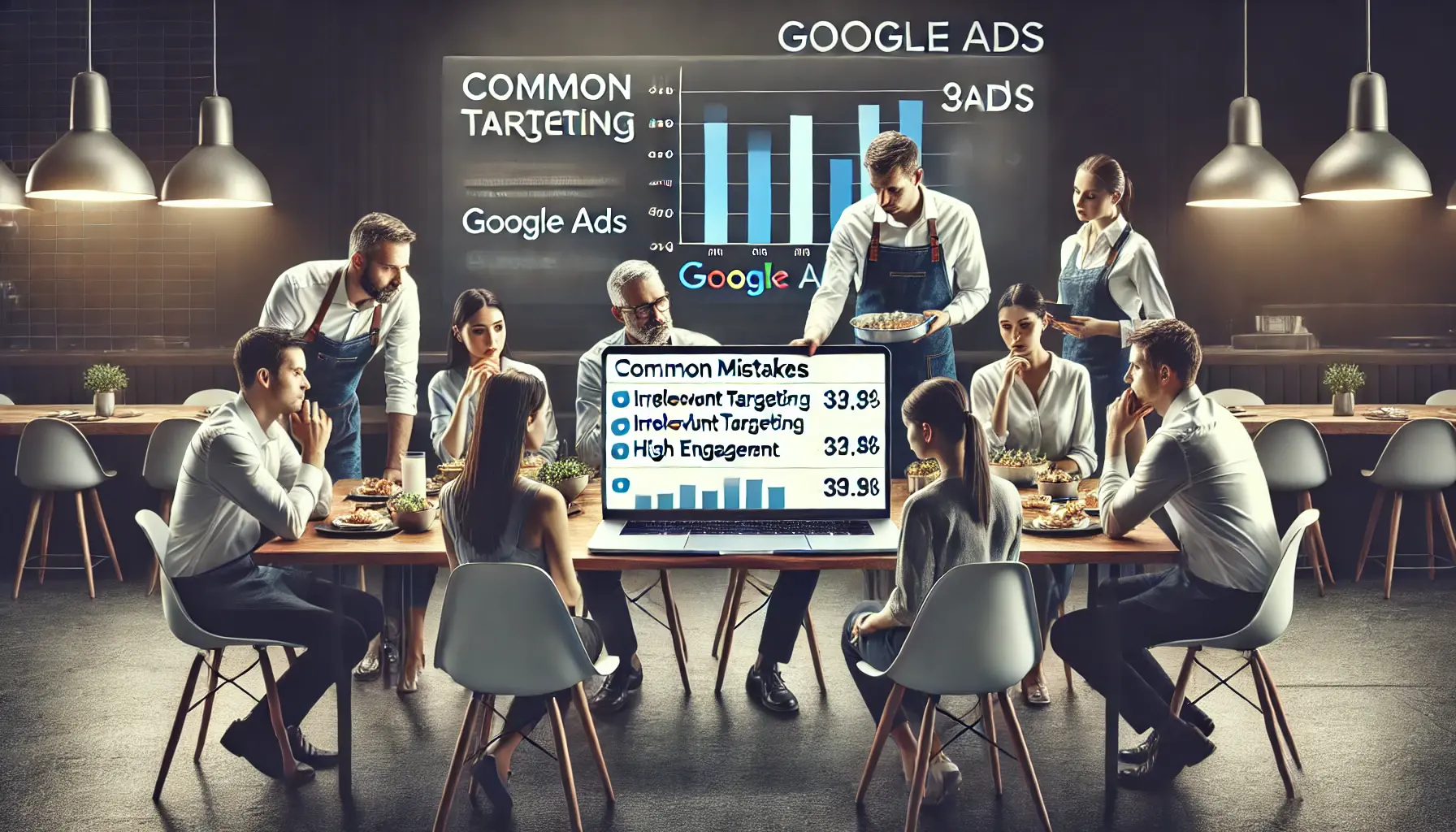
undefined
Common Mistakes to Avoid in Restaurant Google Ads Campaigns
Implementing Google Ads for your restaurant can significantly boost visibility and attract more patrons.
However, certain pitfalls can hinder your campaign’s success.
By being aware of these common mistakes, you can optimize your advertising efforts and achieve better results.

Analyzing and correcting location targeting mistakes in a restaurant’s Google Ads campaign.
Neglecting Location Targeting
For restaurants, attracting local customers is paramount.
Failing to utilize geo-targeting can result in your ads reaching irrelevant audiences, leading to wasted budget and lower conversion rates.
To avoid this:
- Define Your Service Area: Determine the specific geographic regions where your potential customers are located.
- Set Location Targets: In your Google Ads settings, specify the cities, zip codes, or radius to target. This ensures your ads are shown to users within these areas.
- Exclude Irrelevant Areas: To optimize your budget, exclude regions where your restaurant doesn’t serve or where customers are unlikely to travel from.
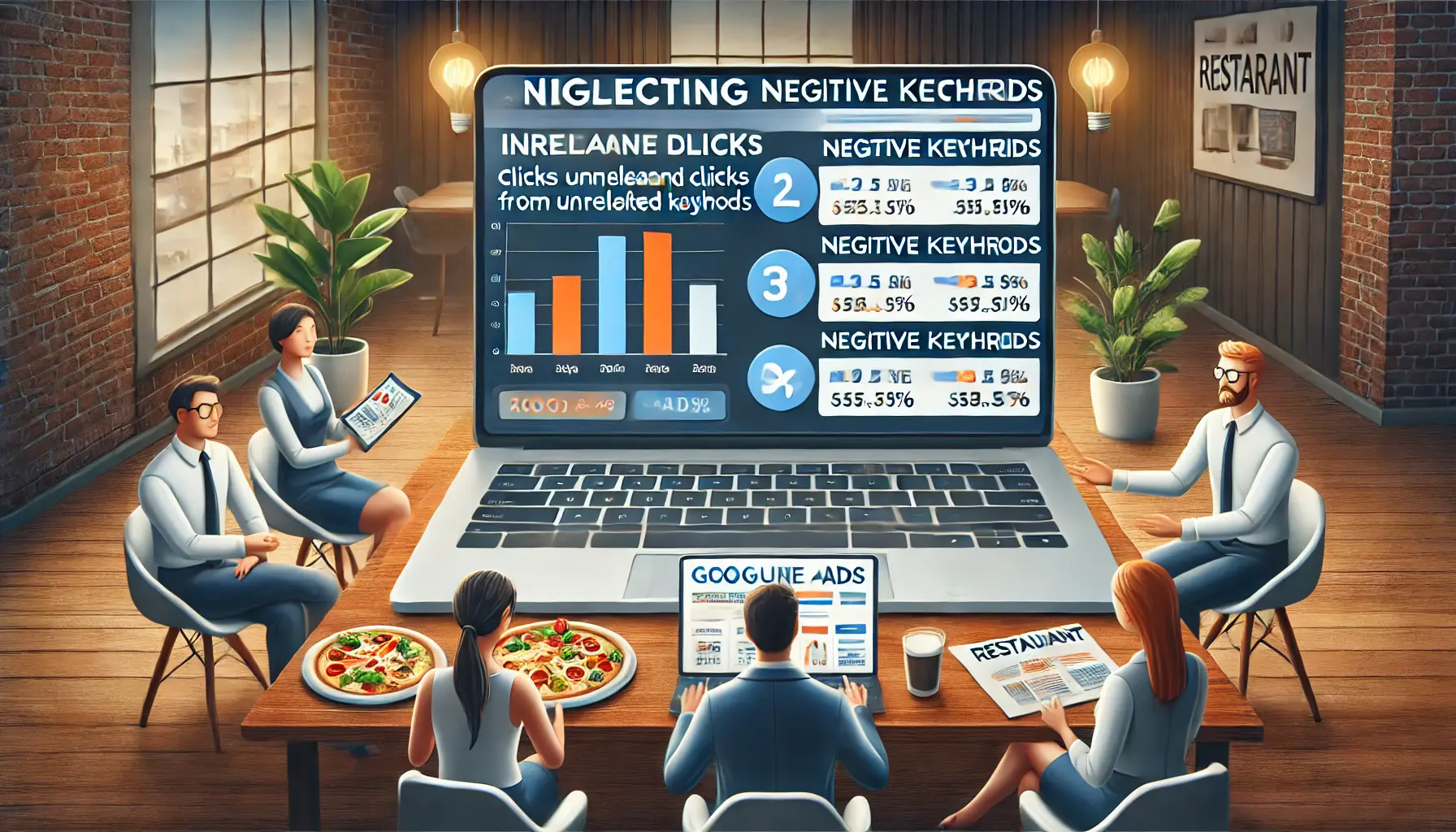
Identifying and correcting the mistake of neglecting negative keywords in a restaurant’s Google Ads campaign.
Neglecting Negative Keywords
Not utilizing negative keywordsTerms added to a campaign to prevent ads from appearing in irrelevant searches. can cause your ads to show for irrelevant searches that will drive unqualified clicks and raise your costs.
To avoid this:
- Identify Irrelevant Terms: Pinpoint keywords unrelated to your restaurant’s offerings.
- Add Negative Keywords: Include these terms in your campaign so that your ads do not appear for unrelated searches.
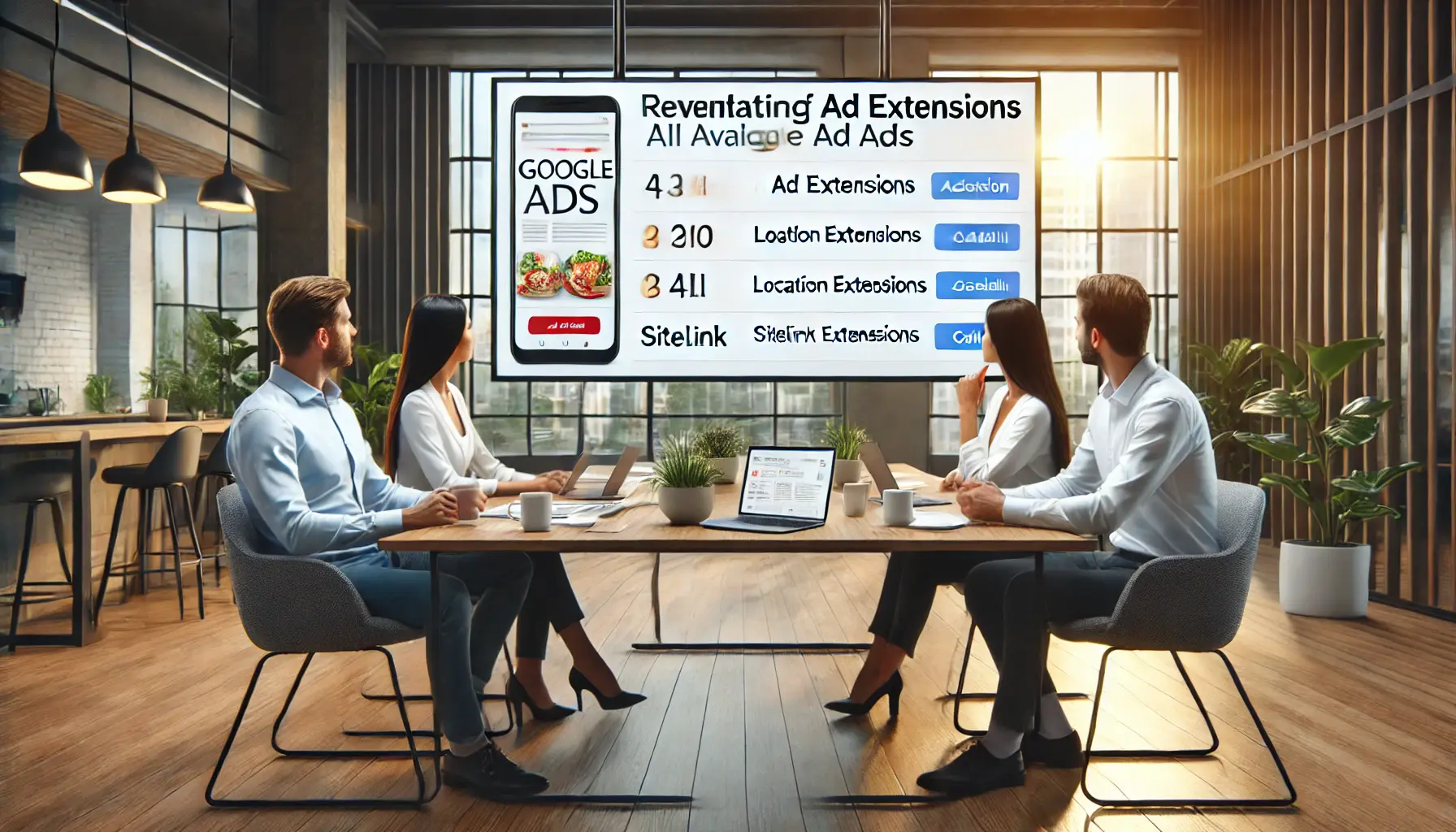
Addressing the issue of neglecting ad extensions to improve restaurant ad performance.
Neglecting Ad Extensions
Ad extensions provide extra information and can improve the visibility and click-through rate of your ad.
Not using them is a missed opportunity to engage prospective customers.
To effectively use ad extensions in your campaigns:
- Location Extensions: Display an address and map to your restaurant, making it easier for people to find you.
- Call Extensions: Add your phone number to the ad, so people can call your restaurant directly.
- Sitelink Extensions: Include links to specific pages on your website, such as the menu, reservations, or special offers.
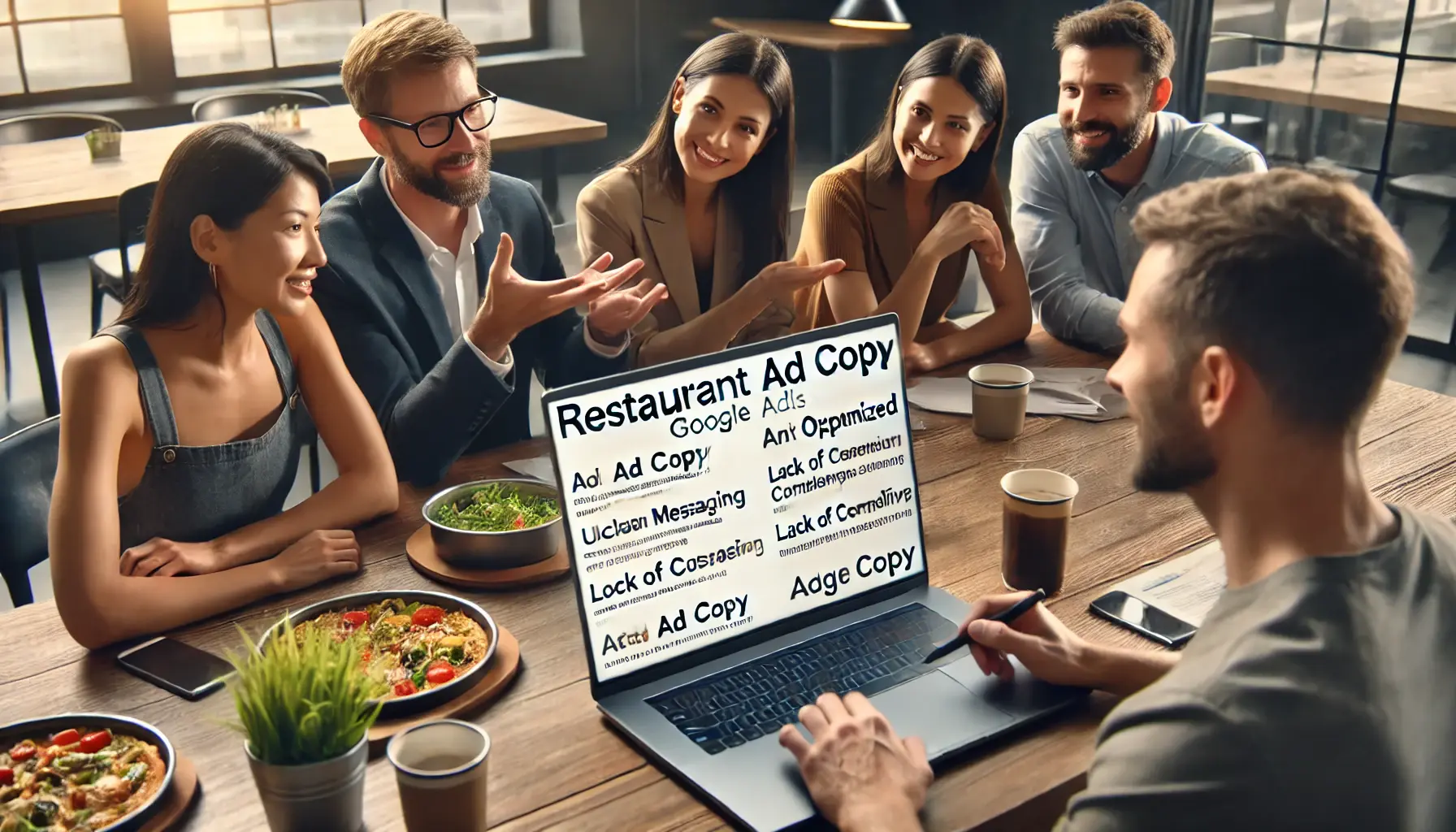
Reviewing and optimizing ad copy to enhance engagement and performance in a restaurant’s Google Ads campaign.
Failing to Optimize Ad Copy
Your ad copy is the first impression potential customers have of your restaurant.
Poorly crafted ads can lead to low engagement and wasted spend.
To improve your ad copy:
- Highlight Unique Selling Points: Emphasize signature dishes, the ambiance of your restaurant, or special dietary options to set your business apart.
- Include a Clear Call-to-Action: Use phrases like “Reserve a Table Now” or “Order Online Today” to encourage further action.
- Incorporate Relevant Keywords: Use terms that diners would commonly search for when looking for restaurants.
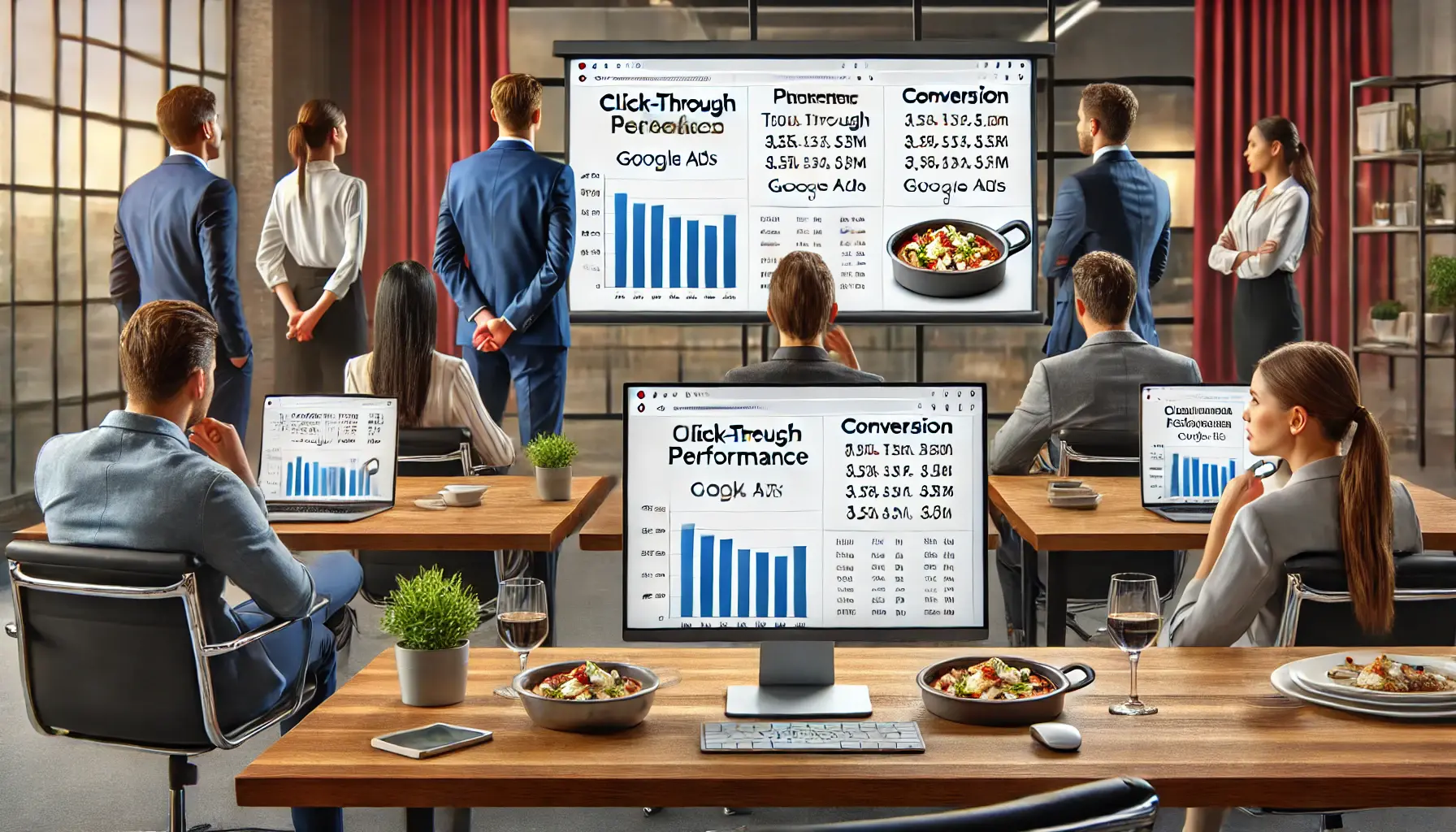
Overlooking campaign performance data and the risks of not monitoring Google Ads campaigns.
Not Monitoring Campaign Performance
You won’t be able to know what works and what doesn’t without regular monitoring.
This can lead to further spending on ineffective strategies.
Monitoring your campaign involves:
- Conversion Tracking: Track actions like reservations, online orders, or calls generated directly from ads.
- Review Key Metrics: Assess performance metrics such as click-through rate (CTR), cost per click (CPC), and conversion rates against your targets.
- Adjust Strategies Accordingly: Refine your targeting, ad copy, and budget allocation using insights gained to make data-driven adjustments.
By avoiding these common mistakes, you can enhance the effectiveness of your Google Ads campaigns, attract more local customers, and maximize your restaurant’s marketing investment.
- Failing to use geo-targeting can waste your budget.
- Neglecting negative keywords leads to irrelevant clicks.
- Ignoring ad extensions reduces ad effectiveness.

undefined
Mastering Google Ads for Restaurants: A Roadmap to Success
Google Ads offers restaurants an unparalleled opportunity to reach potential diners and boost their business.
However, crafting and maintaining a successful campaign requires strategic planning, optimization, and consistent monitoring.
This guide has provided actionable insights into the essentials of Google Ads for restaurants, ensuring you can navigate the complexities with confidence.

undefined
Key Takeaways from Optimizing Google Ads
To achieve success with Google Ads, it’s important to focus on strategies tailored to the unique needs of restaurants.
Here are the essential points:
- Set Clear Goals: Establish specific objectives, such as increasing reservations or promoting new menu items, to guide your campaign’s focus.
- Leverage Geo-Targeting: Ensure your ads are visible to local customers who are most likely to visit your restaurant.
- Utilize Ad Extensions: Add value to your ads with location, call, and promotion extensions to give more reasons to potential diners.
- Focus on Keyword Optimization: Use keywords that are relevant and long-tailed, target better, and include negative keywords to avoid irrelevant searches.
- Track Performance Metrics: Regularly monitor CTR, CPC, ROAS, and conversion rates to assess how the campaigns are performing.
- Avoid Common Mistakes: Steer clear of pitfalls like neglecting location targeting, ad extensions, or performance monitoring, as these can undermine your campaign’s success.

Collaborating on final tips and strategies for successful Google Ads campaigns.
Final Tips for Success
Implementing a Google Ads campaign is just the beginning.
For long-term success, consider the following tips:
- Refresh Ad Creative Regularly: Update your ad copy, visuals, and promotions to keep your audience engaged and avoid ad fatigue.
- Follow Seasonal Trends: Build your campaigns around local events, holidays, and seasonal menu items to ensure your ads stay topically relevant.
- Invest in Remarketing: Re-engage users who have visited your website or viewed your ads without converting into customers yet.
Combining these tips with the foundational elements discussed in this guide will help your restaurant maximize Google Ads to target the right audiences and achieve measurable results.
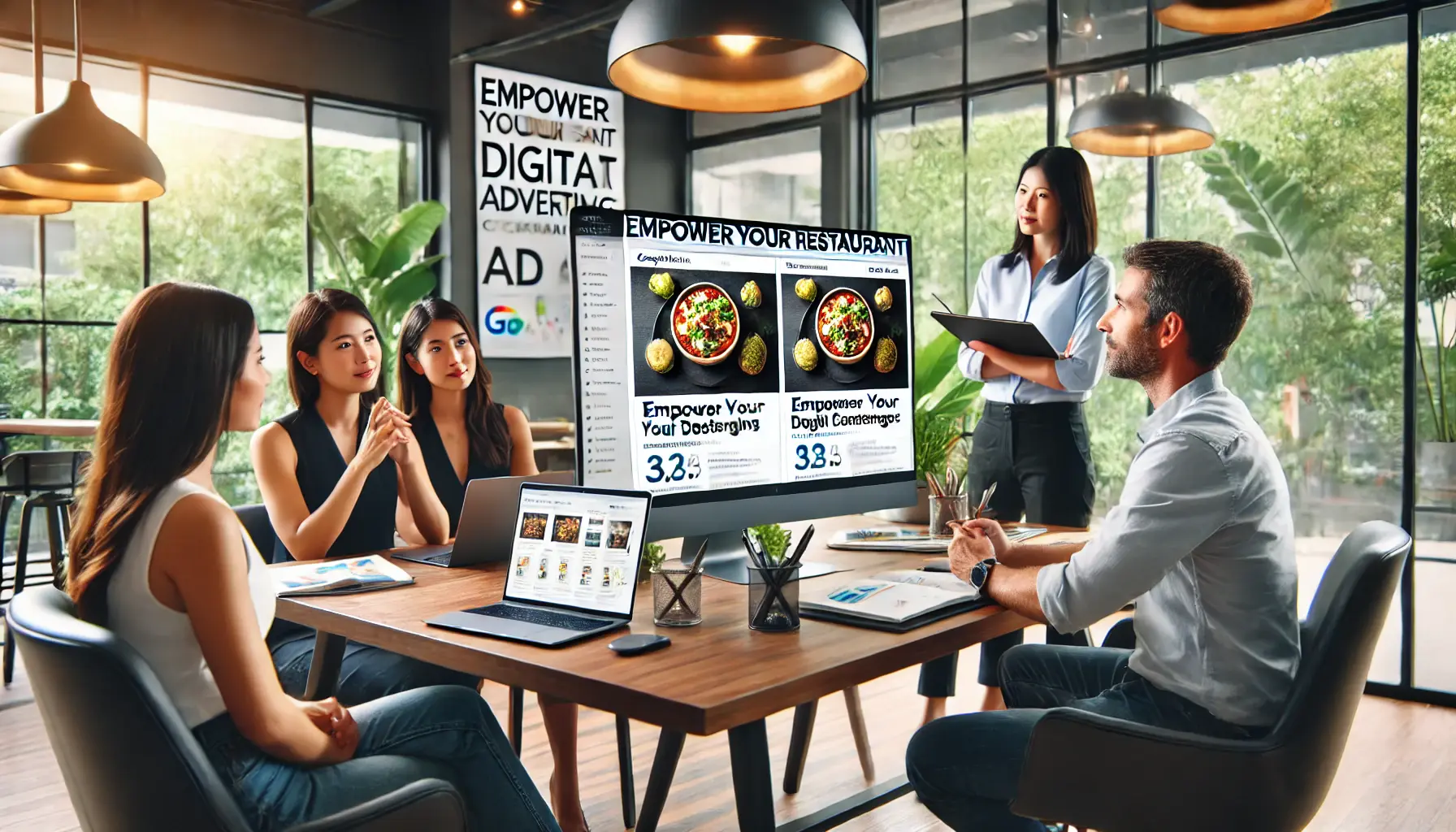
Empowering a restaurant through digital advertising strategies to increase customer engagement.
Empowering Your Restaurant with Digital Advertising
Google Ads has revolutionized the way restaurants connect with their audience.
When used effectively, this platform can significantly enhance your visibility, attract local customers, and drive growth.
Whether you’re a small café or an upscale dining establishment, mastering the strategies shared in this article can transform your advertising efforts and help you stand out in a competitive market.
By knowing your audience, sharpening your campaign tactics, and staying consistent in monitoring and adjustments, you can achieve success with Google Ads.
This will position your restaurant for long-term success in today’s digital world.
- Set clear goals and focus on geo-targeting.
- Utilize ad extensions and refine keyword strategies.
- Monitor performance metrics and avoid common pitfalls.
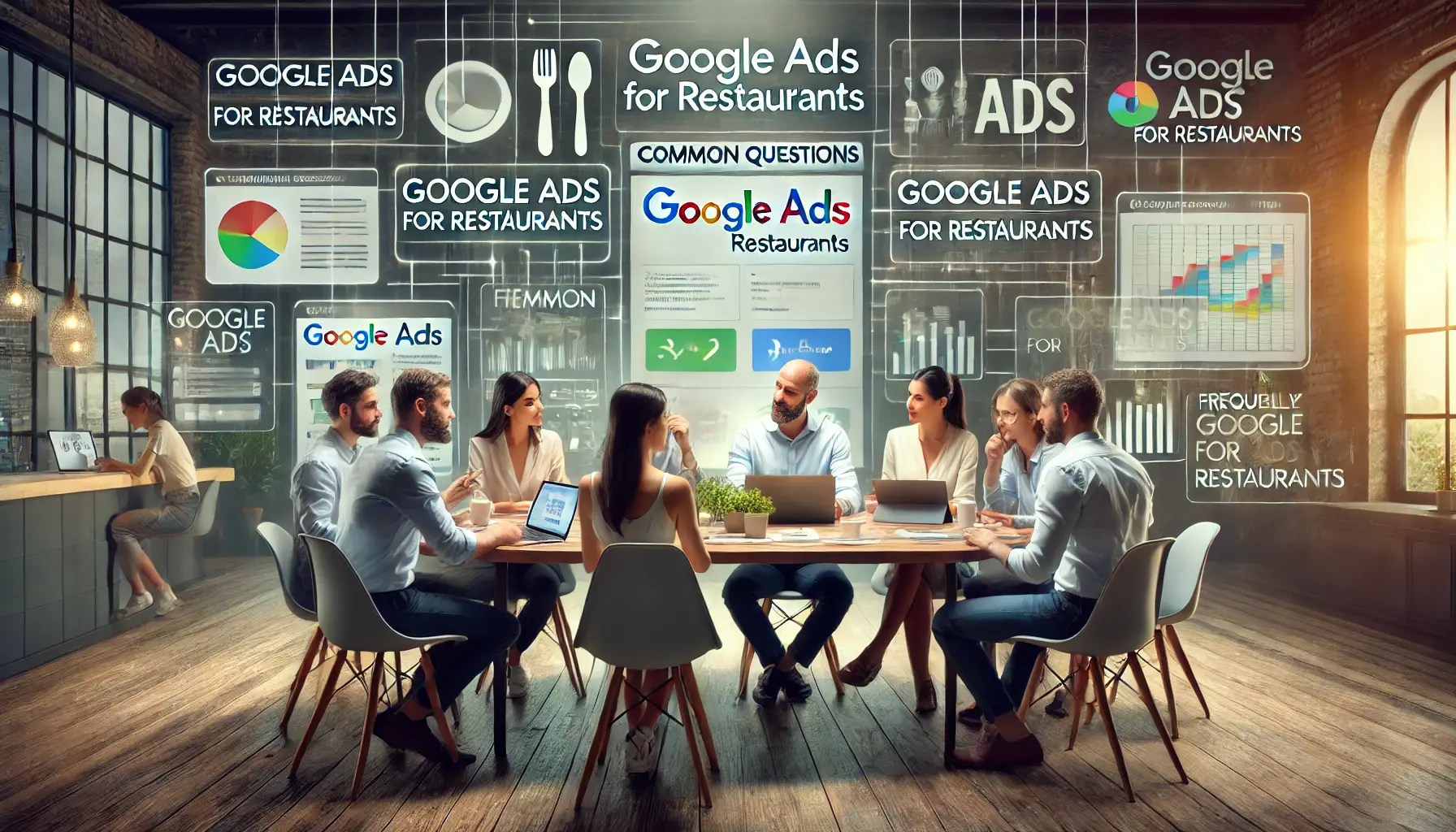
Collaborating to answer frequently asked questions about Google Ads for restaurant marketing.
Your campaigns can be managed by an agency specialized in Google Ads, check out our service page.
Google Ads for Restaurants: Frequently Asked Questions
Answering some of the most commonly asked questions to further assist you in implementing and enhancing your restaurant’s Google Ads campaigns.
The average cost-per-click for search ads in the food and beverages vertical is $1.95.
Utilize geo-targeting by setting location targets in your campaign settings to focus on users within a specific radius of your restaurant.
Ad extensions provide additional information like location, phone number, or links to specific pages, making your ads more informative and increasing click-through rates.
Track key metrics such as click-through rate (CTR), conversion rate, cost-per-click (CPC), and return on ad spend (ROAS) for performance evaluation.
Negative keywords prevent your ads from showing for irrelevant searches, saving unqualified clicks and reducing costs.
Refresh your ad copy regularly to avoid ad fatigueA decline in ad performance due to overexposure to the same audience. and maintain audience interest, especially when promoting new menu items or special offers.
Yes, use ad scheduling to serve ads at peak times when potential customers are most likely to be searching for dining options.
Remarketing targets users who have already visited your website or viewed your ads and entices them to come back and become customers.
Landing pages should be user-friendly, load quickly, and include visible calls-to-action, such as a reservation button or online ordering option.












